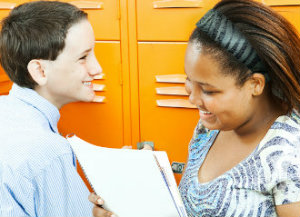Extra Steps to Build Rapport with Inclusion Students
A MiddleWeb Blog
Building a rapport with students is on every What Effective Teachers Do list. The value of the teacher and student connection is discussed in all teacher preparation programs. And it is part of the professional evaluation process, as administrators observe teachers with students.
The New York State Teaching Standards identify the first of seven standards as Know your students and student learning. You probably have something similar in your state, speaking to the important connections educators need to make with those they teach.
In my experience, there are some surefire ways teachers can connect with students:
- Let student interviews reveal their interests and hobbies.
- Provide opportunities for students to connect new learning to their personal experiences and interests.
- Create activities that allow students to take charge of their learning through student-led discussions.
- Relate to students by sharing some of your personal stories and interests.
- Never force a connection—students can see right through it. Allow students to connect to you by your just sharing your personality—your goals—and your mission to guide them to reach their goals.
Extra steps for inclusion classrooms
To build a positive rapport with students with learning disabilities, co-teachers must make time for additional steps. We must go beyond just knowing about students’ hobbies and interests, or sharing a bit of your personal side. Co-teachers must approach each student as a learner with specific challenges. The two teachers in the room must include these elements if we hope to successfully connect with students who have learning disabilities:
- Understand a student’s learning profile
Special education teachers could type up a “cheat sheet” that outlines the student’s strengths and needs, so general education teachers will have this as an at-a-glance reference when lesson planning.
- Learn each student’s personal life story

Take time to listen—it can break any negative cycles and alter their learning path in a positive way. They come to your class to learn—but they also come to your class with a history that shapes their view of themselves as learners. Connect with their view and naturally redirect as needed.
- Plan lessons that align with supporting learner variability
Don’t focus on the student’s disability—embrace the view that all classrooms are filled with students who have a variety of strengths and needs. Students with disabilities are just part of that variability range. Be sensitive to any instructional barriers and clear the way for students to connect to you and the content by applying Universal Design for Learning principles. You can read some of my archived posts (like this one) for further details and examples. Also, check out this link from Center for Applied Technology (CAST)
- Make time to review progress with each student: make it visible – make it real
Make time to meet with the students outside of class time. Have conversations about his or her performance, progress and goals. Let the student lead the discussion accordingly—and guide the exchange in positive directions. Remember, encouraging a growth mindset can set a student up with a long-lasting positive view of himself as a learner.
- In connecting with hard-to-reach students, hold them to high standards
Let these students know you believe in them. Sometimes that’s all it takes. Sometimes students get stuck in a chain of failure that becomes a pervasive negative mindset. You could be that teacher who snaps them onto a more positive learning track. Share your enthusiasm for learning, strategically support their learning in steps, and guide them to achieve at higher levels. Be the magnet that they will be drawn to—rather than the force that repels them.
- Encourage perseverance & don’t reinforce learned helplessness
Understand that students with learning disabilities have experienced years of failing, regardless of their efforts. Over time they often adopt a learned helplessness mindset that leaves them feeling discouraged. They avoid doing the work needed to accomplish academic tasks, figuring, what’s the use—I’m going to fail anyway—I always do.
Teachers should make sure that they do not misunderstand a student’s task avoidance as a student who doesn’t care—or who just won’t put in the effort. Probe your students’ learning history, and be the magnet that pulls and guides students to want to put in their best strategic efforts. Do not be the repelling force that demands students meet high standards without understanding the personal stories behind each student’s behavior. Provide supports, genuine consideration, and viable outlets for students to identify, express, and problem solve learning solutions.
How do you connect?
These are some of my thoughts. What methods have helped you to connect to students with special needs? What success stories are you reminded about as you read this post? What current experiences come to mind? How are you reaching those hard-to-reach students? Share your own expertise!



































